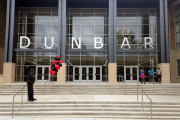WASHINGTON — Did you know there are new rules in place in college basketball this year?
Even if you’re a casual fan, if you’ve watched any hoops yet, you’ve surely noticed the most obvious one. The shot clock has been shortened from 35 seconds to 30 in efforts to speed the game up. But there are actually a number of other rules changes in place, which may be hurting slow, defensive-minded programs.
Officials have been instructed to focus on hand-checking on the perimeter, as well as physicality in post play and ensuring screeners aren’t moving. The restricted arc under the basket has been expanded from 3 feet to 4 feet, pushing defenders further from the rim. They also removed the five-second guarding rule, where tough one-on-one defense could force a turnover simply by maintaining close contact with the player holding the ball.
All of these changes nudge the game toward a higher tempo that favors offenses. This is crucial, as we found in a study last season that a number of teams had begun trending toward a slower pace with increased focus on defense to reduce the number of opportunities for the opposition and effectively shorten the game. The new rules seem like they would have the potential to hurt defensively-minded clubs, and some of the early results tend to support that.
Points per game are up 8.9 percent, from 67.4 to 73.4. That’s roughly in line with the increase of possessions per game (67.3 to 71.0), as both field goals and free throws have gone up. This has manifested in an increase in offensive efficiency, from 99.2 to 102.7 points per 100 possessions, meaning that defenses have been less effective overall.
Virginia currently has the fourth-slowest pace of any team in the country, along with the eighth-ranked adjusted defense (through Monday), per KenPom.com. This makes sense, considering the Cavaliers were the top defensive team in the nation last year, and the third-slowest. But entering the season ranked #6 and considered a potential Final Four candidate, the Hoos were dumped by George Washington in the opening week of the year.
Wisconsin, eighth-slowest of the 351 Division I teams, has lost twice already. Their 10-point, neutral site defeat to Georgetown is understandable, but their two-point home loss to Western Illinois to open the season was a stunner.
Michigan (18th slowest) was crushed by Xavier. And while Northern Iowa (20th-slowest) beat top-ranked North Carolina Saturday, it did so with the Tar Heels missing their star player, Marcus Page. The Panthers opened their season with a home loss to Colorado State.
And there are teams like San Diego State, with the fourth-best defense last year and 18th-slowest tempo (9th/35th this year) which have already lost twice, including an embarrassing 49-43 home defeat to Arkansas-Little Rock.
These are obviously small sample sizes, but they don’t just bode ominously for teams at the top. American, in the middle of a rebuilding year, is running the slowest pace of any team in the country and is winless through three games, losing by an average of nearly 19 points per game.
Tempo certainly isn’t everything, but it’s something worth keeping an eye on for the teams above, as well as those who haven’t been bitten yet. Those include Clemson (3-0, 7th slowest), Saint Mary’s (3-0, 15th), Northwestern (3-0, 21st) and, yes, Maryland (3-0, 23rd). It’s most troubling for the Tigers and Terps, who rely on stronger defenses (15th and 36th-ranked, respectively) coupled with a slower tempo.
The Terrapins were squarely in the middle of the pack last year (201st), but have slowed dramatically in the early going this season. Given the generally plodding nature of the Big Ten, this doesn’t seem to be a trend likely to swing too dramatically the other direction.
How important will defensive efficiency and tempo remain in determining success this year? In 2015, nine of the top 10 and 31 of the top 60 in the country in defensive efficiency made the field of 68. Three of the slowest six in efficiency were high seeds (Wisconsin 1, Virginia 2, Northern Iowa 5), but only 11 of the slowest 50 made it in. That’s not much more than the nine of the fastest 50 in the nation.
As we discovered last year, the trend among Final Four teams has been getting slower, with the average tempo rank over the past five years rising from 112 to 188, and hitting 234 last year. But if early returns are any suggestion of what might happen in March, we may be ready for a swing back in the other direction.





